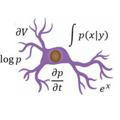
Theoretical Neuroscience IPM
This group is about papers, lectures and useful material of theoretical neuroscience and also about the Theoretical Neuroscience Journal Club which is held in School of Cognitive Sciences, Institute for Research in Fundamental Sciences in Tehran, Iran.
Show more- Subscribers
- Post coverage
- ER - engagement ratio
Data loading in progress...
Data loading in progress...
259120
34330
Classic reinforcement learning (RL) theories cannot explain human behavior in response to changes in the environment or in the absence of external reward. Here, we design a deep sequential decision-making paradigm with sparse reward and abrupt environmental changes. To explain the behavior of human participants in these environments, we show that RL theories need to include surprise and novelty, each with a distinct role. While novelty drives exploration before the first encounter of a reward, surprise increases the rate of learning of a world-model as well as of model-free action-values. Even though the world-model is available for model-based RL, we find that human decisions are dominated by model-free action choices. The world-model is only marginally used for planning but is important to detect surprising events. Our theory predicts human action choices with high probability and allows us to dissociate surprise, novelty, and reward in EEG signals. ### Competing Interest Statement The authors have declared…
30350
25450
1 242140
32490
23530
34020
It is known that the leaky integrate-and-fire neural model shows a transition from irregular to synchronous firing by increasing the coupling between the neurons. However, a quantitative characterization of this order-disorder transition, that is, the determination of the order of transition and also the critical exponents in the case of continuous transition, is not entirely known. In this work, we consider a network of $N$ excitatory neurons with local connections, residing on a square lattice with periodic boundary conditions. The cooperation between neurons $K$ plays the role of the control parameter that generates criticality when the critical cooperation strength ${K}_{c}$ is adopted. We introduce the population-averaged voltage (PAV) as a representative value of the network's cooperative activity. Then, we show that the coupling between the timing of spikes and the phase of temporal fluctuations of PAV defined as $m$ resorts to identify a Kuramoto order parameter. By increasing $K$, we find a continuous…
33600
1 07240
Your current plan allows analytics for only 5 channels. To get more, please choose a different plan.
